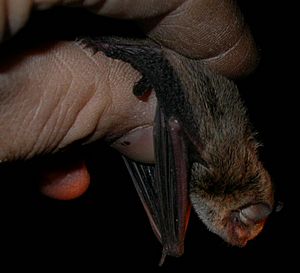Little forest bat facts for kids
Quick facts for kids Little Forest Bat |
|
|---|---|
 |
|
| Conservation status | |
| Scientific classification | |
| Genus: |
Vespadelus
|
| Species: |
vulturnus
|
| Synonyms | |
|
|
The little forest bat (Vespadelus vulturnus) is a tiny bat that belongs to the group called vesper bats. It is part of the family known as Vespertilionidae.
You can find this special bat only in south-eastern Australia, including the island of Tasmania. It is a very small bat, often weighing less than 4 grams (about 0.14 ounces). Some males can weigh as little as 2.5 grams (0.09 ounces)! It is sometimes called Australia's smallest mammal. However, another bat, the Northern Pipistrelle, might be even smaller, weighing around 3 grams (0.11 ounces). The little forest bat is definitely the smallest bat found in Tasmania.
Contents
Where Little Forest Bats Live and What They Eat
The little forest bat is one of the most common bats seen in south-eastern Australia. It lives in many different places. These include Eucalyptus woodlands and forests. You can also find them in rural areas, semi-rural areas, and even some towns.
These bats are insectivores, which means they eat insects. They like to rest and sleep during the day in hollows found inside trees.
Little Forest Bat Life Cycle
Female little forest bats can have babies when they are one year old. Males are ready to mate when they are two years old. It is thought that the males wake up from their winter sleep (called torpor) to mate with the females during the colder months.
A single baby bat, called a pup, is born in the spring. This usually happens in October or November.
How to Identify a Little Forest Bat
The little forest bat is very small. It has fur that is usually pale grey or brownish. The small flap of skin inside its ear, called the tragus, is often white. The skin on its face, feet, and forearm (the part of its wing) is usually pinkish.
Adult bats typically weigh between 2.5 and 5 grams (0.09 to 0.18 ounces). Their forearm is usually less than 30 millimeters (about 1.2 inches) long. The average forearm length is about 28.5 millimeters. Their wings can spread up to 15 centimeters (about 6 inches) wide. Their body length can be up to 5 centimeters (about 2 inches). Female bats are usually a little bit bigger than males.
It can be tricky to tell the little forest bat apart from other similar bats that live in the same areas. These include the Southern forest bat, Vespadelus darlingtoni, Inland forest bat, Vespadelus troughtoni, Vespadelus pumilus, and the Little broad-nosed bat. Scientists often look at a mix of their size and the length of their finger bones to tell them apart.
How Little Forest Bats "See" with Sound
Little forest bats use echolocation to find their way around and hunt for food. This means they send out sounds and listen for the echoes that bounce back. The sound calls they make can be different depending on where the bat lives.
For example, in New South Wales, the main sound frequency of their calls is between 42.5 and 53 kilohertz. This is more than twice the highest sound frequency that humans can hear! So, you cannot hear these bats without a special device called a bat detector.
See also
 In Spanish: Vespadelus vulturnus para niños
In Spanish: Vespadelus vulturnus para niños


